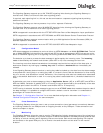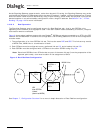
9
Dialogic
®
SS7G2x Signaling Server SGW Mode User Manual Issue 4
The latest software and documentation supporting SS7G2x products is available on the web at
http://www.dialogic.com/support/helpweb/signaling.
The product data sheet is available at
http://www.dialogic.com/support/helpweb/signaling.
For more information on Dialogic
®
SS7 products and solutions, visit
http://www.dialogic.com/support/helpweb/signaling.
When used for M3UA backhaul operation, the Signaling Gateway may operate with an ASP operating either
an Dialogic M3UA Application Server or an Application Server provided by a third party vendor. See the
Dialogic
®
SS7 Protocols Programmer’s Manual for SIGTRAN Host Software for documentation on the
configuration and use of a Dialogic M3UA Application Server.
1.3 Applicability
This manual is applicable to SS7G2x units with software V3.02 and later installed. This manual is not
applicable when operating as a Signaling Interface Unit (SIU) or as a DSC Protocol Converter (DSC). See the
Dialogic
®
SS7G2x SIU Mode User Manual and the Dialogic
®
SS7G2x DSC Mode User Manual for descriptions
use of these modes of operation.
1.4 Hardware Overview
The Signaling Gateway may be purchased as one of two equipment types; SS7G21 and SS7G22. Each
equipment type uses the same chassis and operates with the same software, but differ in the type of pre-
installed SS7 Signaling boards. This provides options in the numbers and types of links and ports available.
An SS7G21 may be purchased with one, two, or three SPCI2S boards (where each board provides four SS7
links, two T1/E1 interfaces and two V.11 serial ports per board) or one, two or three SPCI4 boards (where
each board provides four SS7 links and four T1/E1 interfaces per board).
An SS7G22 may be purchased with one, two or three SS7HDP boards (where each board provides 64 SS7
links and four T1/E1 interfaces per board) with a system maximum of 128 SS7 links.
When T1 or E1 is selected, the Signaling Gateway may be configured to pass the bearer channels from one
PCM port to another, effectively “dropping out” the signaling in line.
See Chapter 2, “Specification” for a full definition of the capabilities of the system.
1.4.1 Part Numbers
See the Dialogic
®
SS7G21 and SS7G22 Hardware Manual for a full list of the ordering codes and definitions
of all of the hardware variants of the two equipment types.
1.5 Connectivity
TDM SS7 signaling can interface to the Signaling Gateway using balanced 1544 kbit/sec (T1) balanced
connections in accordance with G.733 or 2048 kbit/sec (E1) connections in accordance with G.703. SS7
signaling can also be presented on a V.11 (56/64 kbit/sec) synchronous serial interface.
MP2A signaling used for communication between paired Signaling Gateways can be received at the conveter
using 4 x 1 Gbit/sec RJ45 Ethernet™ interfaces.
1.6 User Interface
The Signaling Gateway provides serial port and telnet connections for configuration and management. All
ports provide identical functionality and operate using text-based MML (Man Machine Language) commands
in accordance with CCITT recommendations.
The serial and telnet ports allow the user to configure the Signaling Gateway for operation and to carry out
subsequent modifications to the configuration. They allow the user to read the current status of the various
signaling entities and to view the current active alarms and a history of past alarm events.


















